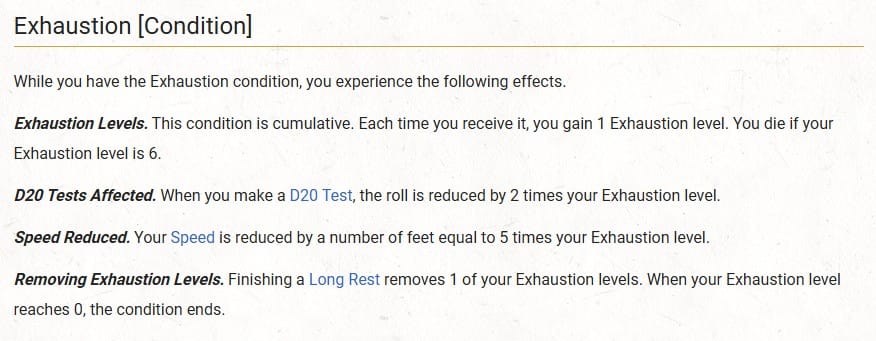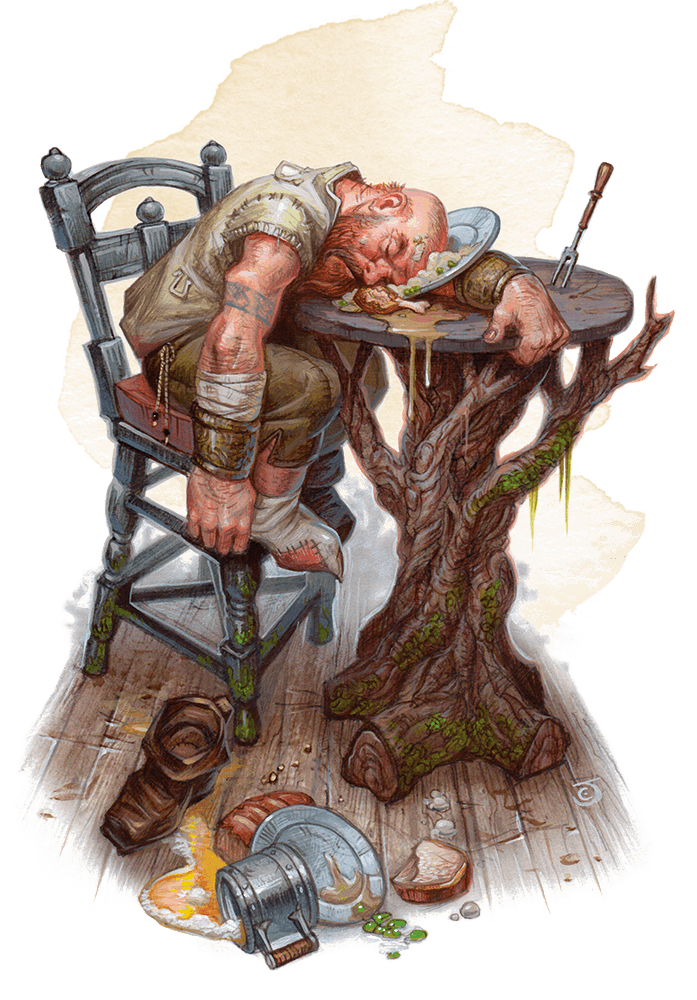Medieval 5e (working title) is a low-fantasy, low-magic, gritty reimagining of 5e. Characters are not epic heroes, they are hardened adventurers, mercenaries, pilgrims, or soldiers. Hit points are lower, combat is deadly, and every decision matters. Exhaustion is an important consideration and has been updated for D&D 5e (2024).
Still, I wanted players to have a sense of agency, the ability to push themselves beyond normal limits, without breaking the grounded tone of the game.
That is where the idea of Stamina came from, to balance the new Exhaustion mechanic.
Endurance: a balancing act.
The original 2014 5e Exhaustion mechanic has always been one of those rules most tables tend to ignore. Well, at least I do, and I know I’m not alone. In my opinion, it’s clunky, cumbersome, and overly granular. Yet the concept behind it, fatigue, strain, and the slow grind of adventuring, fits perfectly within a low-fantasy setting.
It was a pleasant surprise to see the 2024 5e update simplify the Exhaustion system into a cleaner format that scales as a simple modifier to rolls. A welcome and elegant fix.

While I appreciate the streamlined 2024 Exhaustion rule, I think it could have been worded a bit more clearly or even supported with a quick reference table.
The rule currently reads:
“D20 Tests Affected. When you make a D20 Test, the roll is reduced by 2 times your Exhaustion level.”
I’d phrase it more directly as:
D20 Tests Affected: Reduce the result of any D20 Test by 2 × your Exhaustion level.
To make it easier to visualize in play, here is a table.
Standard Exhaustion (2× Level)
| Exhaustion Level | D20 Modifier | Effect |
|---|---|---|
| 1 | –2 | Fatigued: minor strain |
| 2 | –4 | Weary: slowed reaction |
| 3 | –6 | Exhausted: focus fading |
| 4 | –8 | Drained: barely holding on |
| 5 | –10 | Collapsing: near death |
| 6 | — | Collapse (dead or dying) |
Less Severe Exhaustion (1× Level)
| Exhaustion Level | D20 Modifier | Effect |
|---|---|---|
| 1 | –1 | Slightly winded |
| 2 | –2 | Fatigued |
| 3 | –3 | Exhausted |
| 4 | –4 | Faint and struggling |
| 5 | –5 | Collapse imminent |
| 6 | — | Collapse (dead or dying) |
If you prefer a more forgiving tone for your campaign, use the less severe version, it still captures fatigue without overwhelming low-level characters. If you want grittier, high-stakes realism, the standard 2× version keeps exhaustion deadly and impactful.
While Exhaustion was fixed, I still wanted a more holistic approach, one that not only tracked fatigue but also represented its opposite: Stamina. Together, they form a kind of yin-yang system, energy and fatigue, endurance and collapse.
At its core, this mechanic models Endurance: the balance between Stamina and Exhaustion, between pushing your limits and knowing when to rest.
As with all the mechanics I’m designing for Medieval 5e, I wanted it to remain plug-and-play, something you can drop into any d20-based system (5e, Pathfinder, OSR, etc.) with minimal adjustment.
So feel free to lift it, tweak it, and use it in your next game.
The Stamina System
Stamina Pool
Your Stamina Points (SP) represent your reserves of energy, willpower, and grit.
SP = 2 × CON modifier (minimum 2) (maximum 8)
Even if your CON modifier is negative, you still begin with 2 SP.
Example: A Constitution (CON) modifier of 2 = 4 SP (2 x 2)
Note: In Medieval 5e, ability modifiers cap at +4. If your game allows higher modifiers, you may wish to raise or remove the SP cap to maintain balance.
Using Stamina
1. D20 Rolls: Pushing Beyond Limits
You can spend 1 SP to gain +1 to any d20 Test (attack, save, or ability check).
- You may spend up to your CON modifier in SP (minimum 1).
- You can decide to spend Stamina after rolling but before the result is revealed.
Example: Your Ranger has +2 CON. You roll a 12 on your attack. Not sure it’s enough, spend 2 SP to make it a 14.
2. Absorbing Damage: Enduring the Blow
You can spend Stamina to reduce incoming damage on a 1:1 basis, up to your CON modifier per attack. You may do this after damage is rolled.
Example: A fighter with +3 CON takes 7 damage. They spend 3 SP to reduce it to 4.
3. Resisting Fatigue: Pushing Through Hardship
When you would make a saving throw or ability check to avoid gaining a level of Exhaustion (from cold, hunger, forced marches, etc.), you may spend 1 Stamina Point (SP) to roll with Advantage. You must choose to spend the Stamina before rolling.
Example: Your character is exposed to freezing cold and must make a Constitution saving throw or suffer 1 level of Exhaustion. You choose to spend 1 SP to roll the check with Advantage, representing your character digging deep to push through the biting chill.
4. Bloodied: Adrenaline and Desperation
When your hit points fall to 50% or lower, you are Bloodied. Your character is now fighting for their life, life is on the line. This is when a character's adrenaline is pumping.
While Bloodied and in combat:
- On any natural roll of 1 on a d20 (attack, save, or check), you may spend 1 SP to reroll.
- You must take the second result.
Example: Your fighter is locked in melee combat and has just taken a heavy hit that drops them below 50% of their hit points, they are bloodied. Adrenaline surges through their veins; another strike like that could end them. They swing their sword to retaliate but roll a natural 1, a miss. Desperate to stay alive, they grit their teeth and spend 1 Stamina Point (SP), digging deep for one last effort. This time, they roll a 16, turning the miss into a solid hit that just might keep them alive.
Note: You can narrate this to fit your table’s tone, perhaps it’s a wild second swing after a fumble, or a moment of hesitation followed by renewed focus. The mechanic is flexible; let the fiction drive how it feels in the scene.

Recovery
Rest restores both Stamina and Exhaustion, depending on the conditions. However, to maintain the gritty tone and sense of verisimilitude, the body must first recover from Exhaustion before it can regain Stamina.
Note: Medieval 5e distinguishes between two types of Long Rests:
- Unsecured Long Rest (camp, wilderness): You rest uneasily, still in your armor, exposed to the elements, perhaps with danger nearby. Sleep is light and recovery is limited.
- Secured Long Rest (inn, fortress, temple): You remove your armor, enjoy a hot meal and drink, and sleep in safety, in a proper bed. Your body and mind truly relax, allowing for full recovery.
Recovering Exhaustion
- Unsecured Long Rest (camp, wilderness): recover 1 level
- Secured Long Rest (inn, fortress, temple): recover 2 levels
Remedies, potions, perhaps magic or proper care can speed recovery.
Recovering Stamina
You cannot recover Stamina while suffering from any level of Exhaustion. Once fully rested, you may restore SP as follows:
- Short Rest: recover 1 SP
- Unsecured Long Rest: recover CON modifier (minimum 1)
- Secured Long Rest: recover all SP
Recovering Hit Points
While this post focuses on Stamina & Exhaustion, it’s worth including Hit Point Recovery as part of the same endurance framework. Together, these mechanics define the rhythm of survival and recovery in Medieval 5e, where comfort, safety, and rest truly matter.
- Short Rest: Recover Hit Points equal to your CON modifier (minimum 1).
- You do not regain any Hit Dice.
- Unsecured Long Rest: Recover Hit Points equal to your CON modifier (minimum 1).
- You may roll a number of Hit Dice equal to your CON modifier (minimum 1) and add the total to your recovered HP.
- You regain only 1 Hit Die, or none if the rest is interrupted or particularly poor.
- Secured Long Rest: Recover Hit Points equal to your CON modifier (minimum 1) plus one of the following:
- Take the maximum value of a single Hit Die and add it to your recovery, or
- Roll any number of remaining Hit Dice and add the total.
- You regain Hit Dice equal to your CON modifier (minimum 1).
Note: Remedies, potions, or magical healing may enhance recovery at the GM’s discretion.
Conclusion
The design philosophy behind this system is to make Endurance a meaningful part of play, balancing stamina and exhaustion through simple, intuitive mechanics. No lookup tables. No complexity for complexity’s sake. Just clean, easy tracking that reinforces tone and tension at the table.
A few ideas guided me through the design process:
Player Agency
Players should decide when to push their characters and when to hold back. Medieval 5e is a deadly game, there are no resurrections. By giving players control over when to spend stamina or conserve it, they can influence the odds without breaking immersion. It’s not about removing danger; it’s about letting them choose when to face it.
Risk vs. Reward
Balancing mechanics is one of the hardest parts of design. By introducing Stamina as its counterweight, the system restores equilibrium: a negative modifier for fatigue, a positive pool for effort. Players manage both, deciding when to push their luck and when to accept the fatigue. The risk is still there, but now, it’s a choice.
Gritty Realism
I began playing in the 1980s with Moldvay Basic (1981), where characters recovered only 1–3 hit points per full day of rest, a pace that feels incredibly gritty by modern standards. We didn’t question it back then; that was just how the game worked. Looking back, it’s striking how far the pendulum has swung: modern 5e restores 100% of your hit points after a single night’s sleep, turning what was once a hard-fought struggle for survival into a quick reset between battles.
For Medieval 5e, I wanted to find a middle ground, a recovery system that feels realistic and grounded, one that respects the dangers of adventuring without bogging down the game. Resting, exhaustion, stamina, and recovery aren’t designed to be gritty for the sake of grit, nor are they a simple “heal to full” button like in modern 5e. They’re part of a broader design philosophy: to make Endurance a central pillar of play.
Stamina replace the superhero endurance of modern 5e with something more human, a system that rewards grit, preparation, and survival instinct. It turns rest and recovery into part of the player’s decision-making process, where the choice to push forward, retreat, or rest carries real weight.
I believe I’ve found that balance and achieved the design goal I set out for.
A simple, flexible, and plug-and-play system compatible with nearly any d20-based game, whether you’re running 5e, Pathfinder, Shadowdark, or your favorite OSR ruleset.
Make sure to subscribe to the newsletter to get notified when new Medieval 5e posts go live. You can also explore more articles on Medieval 5e here.


Member discussion: